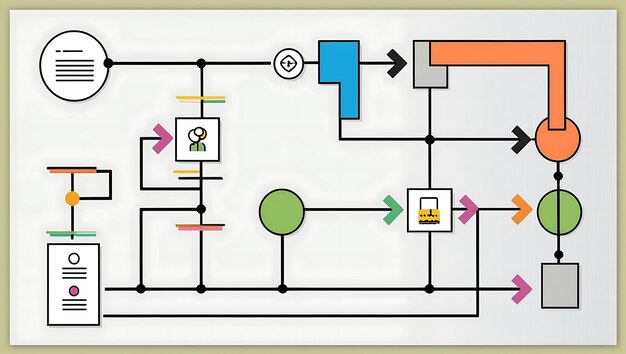Agile Development: Accelerate Product Iteration in US Startups

Implementing agile development within US startups streamlines product iteration by fostering adaptive planning, early delivery, and continuous improvement, directly addressing market demands and competitive pressures for rapid, value-driven software deployment.
In the dynamic landscape of US startups, the ability to rapidly innovate and adapt is not merely an advantage but a necessity. Understanding How to Implement Agile Development for Faster Product Iteration in US Startups? is crucial for those aiming to outpace competitors and meet evolving customer needs with precision and speed. This approach transforms the traditional development cycle, offering a pathway to sustained growth and market relevance.
understanding agile development and its advantages for startups
Agile development is a set of principles and practices that advocates for adaptive planning, evolutionary development, early delivery, and continuous improvement. It encourages rapid and flexible response to change, distinguishing itself from traditional linear methodologies. For US startups, where speed of execution and market responsiveness are paramount, agile methodologies offer a significant competitive edge.
The core philosophy of agile centers on delivering value incrementally, allowing teams to gather feedback early and often, thereby reducing the risk of developing products that miss market needs. This iterative nature inherently supports faster product iteration, enabling startups to validate ideas, pivot quickly, and optimize their offerings based on real-world user data rather than speculative assumptions.
key agile principles in a startup context
Several principles underpin agile, each holding particular resonance for a startup. Customer collaboration, for example, is prioritized over contract negotiation, fostering a relationship where the end-user’s needs directly shape the product. This direct feedback loop is invaluable for young companies attempting to find product-market fit.
- Individuals and Interactions: Emphasizes the importance of people and how they work together over rigid processes and tools.
- Working Software: Prioritizes functional software as the primary measure of progress, rather than extensive documentation.
- Customer Collaboration: Highlights the value of engaging directly with customers throughout the development cycle.
- Responding to Change: Favors adapting to change over strictly adhering to an initial plan, crucial in volatile startup environments.
Another principle, the preference for working software over comprehensive documentation, aligns perfectly with the lean startup philosophy. Instead of spending excessive time on detailed specifications that might change, agile encourages building minimal viable products (MVPs) and refining them through iterative cycles. This expedites time-to-market and allows for quicker monetization or validation.
Ultimately, agile provides a structured yet flexible framework that empowers startups to build products swiftly, efficiently, and effectively. It cultivates an environment of continuous learning and adaptation, which is vital for navigating the unpredictable journey of a young company. The initial steps involve embracing these principles at an organizational level, creating a culture that supports iterative development and collaborative problem-solving.
choosing the right agile framework for your startup
While the principles of agile are universal, different frameworks offer varied approaches to implementation. Selecting the appropriate framework is a critical decision for US startups seeking to optimize their product iteration process. Each framework has its strengths, making some more suitable for particular team structures, product types, or organizational sizes.
Scrum is arguably the most popular agile framework, widely adopted for its simplicity and effectiveness. It organizes work into short, time-boxed iterations called “sprints,” typically lasting one to four weeks. Within each sprint, a cross-functional team works to complete a set of clearly defined product backlog items, leading to a potentially shippable increment.
scrum specifics and benefits for startups
Scrum’s structured events—sprint planning, daily stand-ups, sprint review, and sprint retrospective—provide a clear rhythm for development. For startups, this rhythm creates a predictable cadence for delivering value and gathering feedback, which is essential for managing investor expectations and maintaining market momentum. The daily stand-ups ensure alignment and quick problem-solving, preventing minor issues from escalating.
- Daily Scrums: Foster communication and identify impediments early.
- Sprint Reviews: Facilitate stakeholder feedback on delivered increments.
- Sprint Retrospectives: Promote continuous process improvement within the team.
Alternatively, Kanban offers a more fluid approach, focusing on visualizing workflow, limiting work in progress (WIP), and maximizing efficiency. Unlike Scrum’s fixed sprints, Kanban uses a continuous flow model, allowing new items to be pulled into the workflow as capacity becomes available. This can be particularly beneficial for startups dealing with unpredictable new requests or maintenance tasks.
Choosing between Scrum and Kanban often depends on the nature of the work. If a startup needs a predictable delivery schedule and prefers to plan work in batches, Scrum might be ideal. If the workflow is highly variable and continuous delivery is a priority, Kanban could be a better fit. Some startups even benefit from a hybrid approach, combining elements of both to suit their unique needs.
The decision should involve the entire development team, considering their comfort level with different structures and the specific challenges of the product being built. A pilot phase with a chosen framework can also help determine its suitability, allowing for adjustments before full-scale implementation.
building a high-performing agile team
The success of agile development in a startup hinges significantly on the quality and structure of its teams. Building a high-performing agile team involves more than just assembling individuals; it requires fostering a culture of collaboration, empowerment, and continuous learning. For US startups, this means emphasizing cross-functionality and self-organization.
An ideal agile team is cross-functional, meaning its members possess all the skills necessary to take an item from concept to deployed reality. This includes designers, developers, quality assurance engineers, and sometimes even product owners or business analysts embedded within the team. This structure minimizes dependencies on external departments, accelerating decision-making and product delivery.

Self-organization is another cornerstone. Agile teams are empowered to decide how best to accomplish their work rather than being micromanaged. This autonomy fosters a sense of ownership and responsibility, leading to higher quality work and increased team morale. For startups, this translates to faster adaptation, as teams can respond directly to challenges without layers of bureaucracy.
roles and responsibilities in an agile environment
While agile teams are self-organizing, specific roles often emerge to facilitate the process. The Product Owner is responsible for defining and prioritizing the product backlog, ensuring the team is always working on the most valuable items. The Scrum Master, in Scrum teams, acts as a facilitator, removing impediments and coaching the team on agile practices.
- Product Owner: Maximizes the value of the product resulting from the work of the Development Team.
- Scrum Master: Ensures the team adheres to Scrum principles and practices, and removes impediments.
- Development Team: Creates the product increment, comprising cross-functional individuals.
Beyond formal roles, clear communication and psychological safety are critical. Teams must feel comfortable voicing concerns, sharing ideas, and admitting mistakes without fear of repercussion. This open environment is crucial for effective problem-solving and rapid learning—qualities that are extremely valuable in the fast-paced startup world. Investing in team-building activities and promoting transparency can help cultivate this positive dynamic.
Recruiting the right talent is just the beginning. Continuous investment in training and development, particularly in agile methodologies and technical skills, ensures the team remains sharp and responsive to technological shifts. By focusing on these elements, startups can build the robust, adaptable teams needed to drive continuous product iteration and achieve market success.
effective backlog management and sprint planning
At the heart of faster product iteration in agile lies effective backlog management and diligent sprint planning. These processes ensure that development efforts are consistently aligned with strategic goals and customer needs, preventing wasted effort and enhancing efficiency for US startups.
The product backlog serves as the single source of truth for all proposed product changes, enhancements, and bug fixes. It is a dynamic, ordered list of features, functionalities, requirements, and fixes that a team needs to deliver. The Product Owner is primarily responsible for its management, refining items, estimating their size, and prioritizing them based on business value, risk, and dependencies.
prioritization strategies for startups
Given the limited resources and rapid pace of startups, effective prioritization is paramount. Techniques like MoSCoW (Must-have, Should-have, Could-have, Won’t-have) or RICE (Reach, Impact, Confidence, Effort) scoring can help product owners systematically evaluate and rank backlog items. This ensures that the most impactful features are developed first, providing immediate value to users and stakeholders.
- MoSCoW Method: Categorizes requirements into four priority levels based on urgency and importance.
- RICE Scoring: Quantifies priority using reach, impact, confidence, and effort to make data-driven decisions.
Sprint planning is a critical event where the development team selects a subset of items from the prioritized product backlog to work on during the upcoming sprint. During this meeting, the team collectively decides what they can realistically achieve in the given sprint duration, breaking down larger items into smaller, manageable tasks. This commitment ensures focus and accountability.
For startups, maintaining a lean and continuously refined backlog is crucial. Over-committing or allowing the backlog to become unwieldy can lead to confusion and slow down iterations. Regular backlog refinement sessions, often called “backlog grooming,” help keep the list current, relevant, and well-understood by the entire team. This activity ensures that when sprint planning occurs, the team is working with well-defined, actionable items.
The goal is not simply to complete tasks, but to deliver valuable, working software at the end of each sprint. By mastering backlog management and sprint planning, US startups can ensure their product development cycles are efficient, focused, and directly contribute to faster, more effective product iteration.
leveraging continuous integration and delivery (CI/CD)
To truly achieve faster product iteration, US startups must go beyond just adopting agile methodologies; they need to embrace the engineering practices that support them, primarily Continuous Integration (CI) and Continuous Delivery (CD). CI/CD pipelines automate significant parts of the software development lifecycle, dramatically reducing the time from code commit to deployment.
Continuous Integration (CI) is the practice of frequently merging code changes from multiple contributors into a central repository. Each merge triggers a series of automated builds and tests to detect integration errors early. For startups, this means that code conflicts and bugs are identified and fixed quickly, preventing them from accumulating into larger, more complex problems.
benefits of automated testing in CI/CD
A robust suite of automated tests, including unit, integration, and end-to-end tests, is fundamental to CI. These tests provide immediate feedback on the health of the codebase, giving developers confidence that their changes haven’t introduced regressions. This confidence allows for more frequent and smaller code changes, which are inherently less risky and easier to manage in a fast-paced startup environment.
- Early Bug Detection: Identifies integration issues and regressions almost immediately after code is committed.
- Increased Code Quality: Ensures consistent coding standards and functionality through automated checks.
- Reduced Manual Effort: Frees up developers from repetitive testing tasks, allowing them to focus on innovation.
Continuous Delivery (CD) extends CI by automating the release process to a production-ready environment, making it possible to deploy new changes to users at any time. When a CI build passes all tests, CD ensures that the software is automatically prepared and made ready for production deployment. This doesn’t mean every change is immediately pushed live, but rather that it could be, at the push of a button.

For startups, CI/CD is a game-changer for product iteration. It eliminates manual deployment bottlenecks, ensures consistent deployment environments, and significantly shortens the feedback loop. New features or bug fixes can be released to users within minutes or hours, rather than days or weeks. This speed is critical for learning from user behavior, conducting A/B tests, and responding rapidly to market shifts.
While setting up a robust CI/CD pipeline requires an initial investment in tools and expertise, the long-term benefits in terms of developer productivity, product quality, and speed of iteration far outweigh the costs. It empowers startups to scale their development efforts efficiently while maintaining high standards and delivering value continuously, enabling truly faster product iteration.
measuring success and continuous improvement
Implementing agile development for faster product iteration in US startups is not a one-time setup; it’s an ongoing journey of measurement, adaptation, and continuous improvement. To truly leverage agile, startups must establish clear metrics for success and embed a culture of learning and refinement into their operations.
Measuring success in agile involves looking beyond mere task completion. Key performance indicators (KPIs) should focus on value delivered, team efficiency, and product quality. Metrics such as lead time (from idea to delivery), cycle time (from start of work to delivery), and deployment frequency are critical for understanding the speed of iteration. Higher deployment frequency and shorter lead times indicate a more agile and responsive development process.
essential agile metrics for startups
Beyond speed, metrics related to product value are essential. Customer satisfaction scores (CSAT), Net Promoter Score (NPS), and feature adoption rates provide insights into how well the product is meeting user needs. For a startup, identifying product-market fit and validating assumptions is paramount, and these metrics directly reflect that.
- Lead Time: Time from feature idea generation to deployment to production.
- Cycle Time: Actual time spent working on a feature from start to finish.
- Deployment Frequency: How often new changes are released to users.
- Throuphput: The number of stories or features completed over a period.
Continuous improvement is baked into agile methodologies, particularly through the sprint retrospective in Scrum and regular review sessions in Kanban. These structured meetings provide forums for teams to reflect on their past work, identify what went well, what could be improved, and commit to actionable changes for the next iteration. This iterative self-correction is vital for maintaining productivity and adapting to evolving challenges.
For startups, the ability to adapt quickly based on data is a competitive advantage. Regularly reviewing these metrics and openly discussing them within the team and with stakeholders fosters transparency and encourages data-driven decision-making. It also reinforces the idea that learning from failures and optimizing processes is as important as delivering new features.
Embracing a culture of experimentation and feedback loops, where new ideas are tested, measured, and refined, ensures that the agile implementation remains effective and responsive to the unique demands of the startup ecosystem. This dedication to continuous improvement ensures faster product iteration is not just a goal, but a living reality for US startups.
overcoming common agile implementation challenges in startups
While the benefits of agile development for faster product iteration are clear, US startups often face unique challenges during its implementation. Recognizing and addressing these hurdles proactively is key to a successful transition and sustained agility.
One prevalent challenge is resistance to change. Employees accustomed to traditional methodologies may find the shift to agile’s dynamic, iterative nature unsettling. This can manifest as reluctance to embrace self-organization, fear of transparency, or difficulty in letting go of rigid plans. Overcoming this requires strong leadership buy-in, clear communication about the “why” behind the change, and continuous training to build new skills and mindsets.
addressing common pitfalls
Another common pitfall is the tendency to adopt agile superficially, known as “doing agile” rather than “being agile.” This means following the processes (like daily stand-ups) without truly internalizing the underlying principles of collaboration, continuous improvement, and customer focus. Startups might use arbitrary sprint lengths or neglect retrospectives, undermining the very benefits agile seeks to provide.
- Lack of Buy-in: Ensure leaders and team members understand and commit to agile principles.
- Scope Creep: Maintain a disciplined product backlog and clear sprint goals to prevent uncontrolled changes.
- Resource Constraints: Prioritize ruthlessly and manage expectations regarding what can be achieved with limited resources.
Resource constraints are particularly acute in startups. Small teams often wear multiple hats, and the pressure to deliver quickly can lead to “shortcut agile” where essential practices like comprehensive testing or regular refactoring are deprioritized. This can accumulate technical debt, slowing down future iterations. Startups need to strike a balance, understanding that investing in quality upfront prevents bigger problems later.
Finally, managing stakeholder expectations can be tricky. Investors and business leaders, accustomed to fixed timelines and detailed Gantt charts, may struggle with agile’s emphasis on flexibility and iterative learning. Educating stakeholders about agile principles, focusing on value delivered per sprint rather than rigid endpoints, and demonstrating visible progress frequently can help build trust and alignment.
Overcoming these challenges requires patience, persistence, and a commitment to continuous learning at an organizational level. By fostering a supportive culture, providing adequate training, and remaining disciplined in applying agile principles, US startups can successfully navigate these hurdles and fully harness agile for accelerated product iteration and sustained growth.
| Key Point | Brief Description |
|---|---|
| 🚀 Speed to Market | Agile enables rapid product launches through iterative development. |
| 💡 Customer Focus | Continuous feedback loops ensure products meet market demands. |
| 🛠️ Adaptability | Teams can pivot swiftly in response to changing requirements. |
| 📈 Continuous Improvement | Regular retrospectives refine processes and enhance team performance. |
frequently asked questions about agile for startups
The primary benefit of agile for US startups is significantly faster product iteration. This allows them to quickly respond to market feedback, validate ideas with minimal investment, and deploy features more frequently. It results in a product that evolves rapidly, staying highly relevant to customer needs and competitive pressures.
Neither Scrum nor Kanban is universally “better”; suitability depends on the startup’s specific context. Scrum offers a structured, time-boxed approach suitable for stable product backlogs and predictable iterations. Kanban is more flexible, ideal for unpredictable workflows or maintenance-heavy tasks, focusing on continuous flow and limiting work in progress. Many startups find a hybrid approach effective.
CI/CD (Continuous Integration/Continuous Delivery) automates the build, test, and deployment processes, drastically reducing the time it takes to get new code into production. This automation enables developers to push small, frequent changes with confidence, minimizing integration issues and allowing for rapid feedback loops from users, directly accelerating product iteration cycles.
Common challenges include resistance to change from traditional mindsets, the temptation to “do agile” superficially without embracing its core principles, and managing resource constraints typical for startups. Additionally, setting realistic expectations with stakeholders and avoiding technical debt due to rapid development are persistent hurdles.
Team structure is critically important. Agile thrives on cross-functional, self-organizing teams where members possess diverse skills to complete tasks independently. This autonomy and comprehensive skill set within the team minimize external dependencies and bottlenecks, ensuring faster decision-making and more efficient workflow, directly supporting rapid product iteration.
conclusion
Mastering the implementation of agile development is not just about adopting a new process; it’s about fundamentally transforming how US startups innovate and bring products to market. By fostering adaptive planning, empowering cross-functional teams, leveraging automation through CI/CD, and committing to continuous improvement, startups can achieve an unparalleled pace of product iteration. This ability to rapidly learn, adapt, and deliver value ensures sustained competitiveness and relevance in an ever-evolving technological landscape, paving the way for lasting success.





